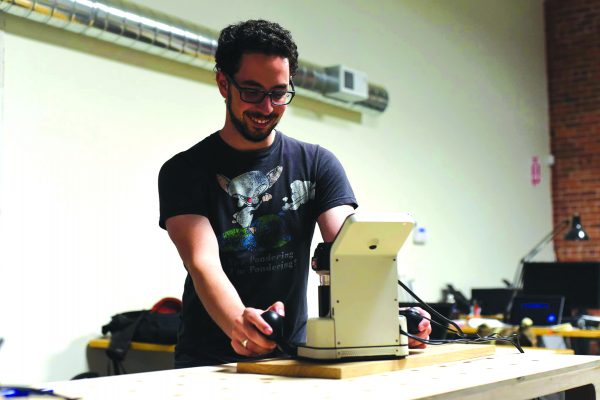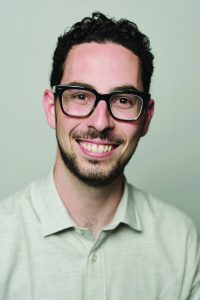
When Jeremy Blum, 26, needs something, he just builds it.
The Armonk native and San Francisco transplant could never remember to bring his umbrella. So, he designed an umbrella stand that lights up when the forecast calls for rain. Not only that, the erudite electrical engineer’s stand is a customized 3D print, which also pings your phone if, despite the illuminated stand, you still forget your umbrella.
“You can teach yourself pretty much anything if you’re willing to spend a few hours on the Internet,” said Blum, head of electrical engineering at Shaper, a young company that makes hand-held robotic power tools.
In January, Forbes Magazine listed the prolific inventor as one of its 30 under 30 in the manufacturing and industry category. Forbes cites his work on Google Glass, his multiple patents and popular YouTube channel–which has many millions of views–dedicated to teaching people about electrical engineering.
“For me, something that’s really important is engineering education and basically making the prospect of building things cheaper and easier, and more accessible to more people,” he said, eager to bring up the subject.
“Because, I think if we have more people who are literate at building things and making things then we’re more likely to have people who are solving problems in a positive way that can impact the world.”

At age 23, Blum published a book, “Exploring Arduino,” with the same intent, by walking readers through the “prototyping platform for embedded electronics” called Arduino.
“It’s basically an easy way to get started designing electronic systems,” he said. Blum describes it as a self-help book for self-starters. The book has been translated into several languages and is used at universities across the country, including his alma mater, Cornell University.
“Actually, this book was inspired by my class, and Jeremy did a great job presenting the key concepts of Arduino programming,” said Francois Guimbretière, associate professor at Cornell University and Blum’s professor for the rapid prototyping class where he first learned about Arduino. “It is only fitting for me to adopt it as a textbook.”
“I once asked him, ‘What is his dream life like?’” said Brenda Wilder, Blum’s grandmother, whose career teaching college-level biology sparked his early interest in science. “And he said, ‘Well, I do want to make money. But, only because I want to be able to stop working and get involved in projects like STEM (science, technology, engineering and math). In other words, help students learn science… He’s very altruistic, his heart is very much in the right place and I think one day he’s going to make a very big difference in this world. He actually already has.” The most high-profile of which is Google Glass, which took the world by storm in 2012.
“For a variety of technical, but more so social reasons, I don’t think it was every really destined to be the consumer product that people envisioned it might be,” said Blum, who worked on its system architecture and electrical design.
After Google Glass lost its luster in the public eye, Google refocused the product for enterprise situations, like assembly lines, medicine and health care, which Blum said is a lot of what he worked on.
He left Google X, an innovation lab under the Google umbrella at the time of his employment, for Shaper in October 2015 wanting to work on something new.
At a recent symposium for Byram Hills High School’s Science Research Program, Blum returned home to give a keynote address and show off some of the cool stuff he’s inventing these days. “He’s a real legacy here and we talk about him a lot,” said Stephanie Greenwald, one of the teachers for the Authentic Science Research Program at Byram Hills High School. “And he was so the same, genuine and kind and giving.”
The school’s Science Research Program, one of the first in the country, is a three-year science elective course in which students pick a topic, identify and work with a mentor in a related field and produce an original piece of research.
Combining his passion to help people with his interest in robotics, Blum designed and built a prosthetic control technology that used force sensors to supplement existing technology to build a prosthetic hand. His design was also intended to make the prosthetic more cost effective.
“Jeremy was always tinkering with something. I think his philosophy was something like, ‘Gee, I wonder if I could…’ and then he would,” said David Keith, director of the school’s Authentic Science Research Program.
At Cornell, Blum continued exploring robotics, while studying electrical and computer engineering for both his undergraduate and master’s program.
“Once you’ve built a bunch of stuff you just start to get a sense, kind of like a sixth sense, of what you need to make something happen,” he said.
Now, at Shaper, his focus is making power tools that make it easier for people to make their own things.
“I think it’s every person’s responsibility to leave some sort of positive impact on the world,” he said. “And I think there’s two ways to do that. You either directly impact people’s lives in some way… or, you make the tools that make it easier for a larger group of people to kind of pave their own way.”
Brian Donnelly is a Westchester native. He has been a local reporter in Westchester, national news health editor and public relations and social media specialist.
